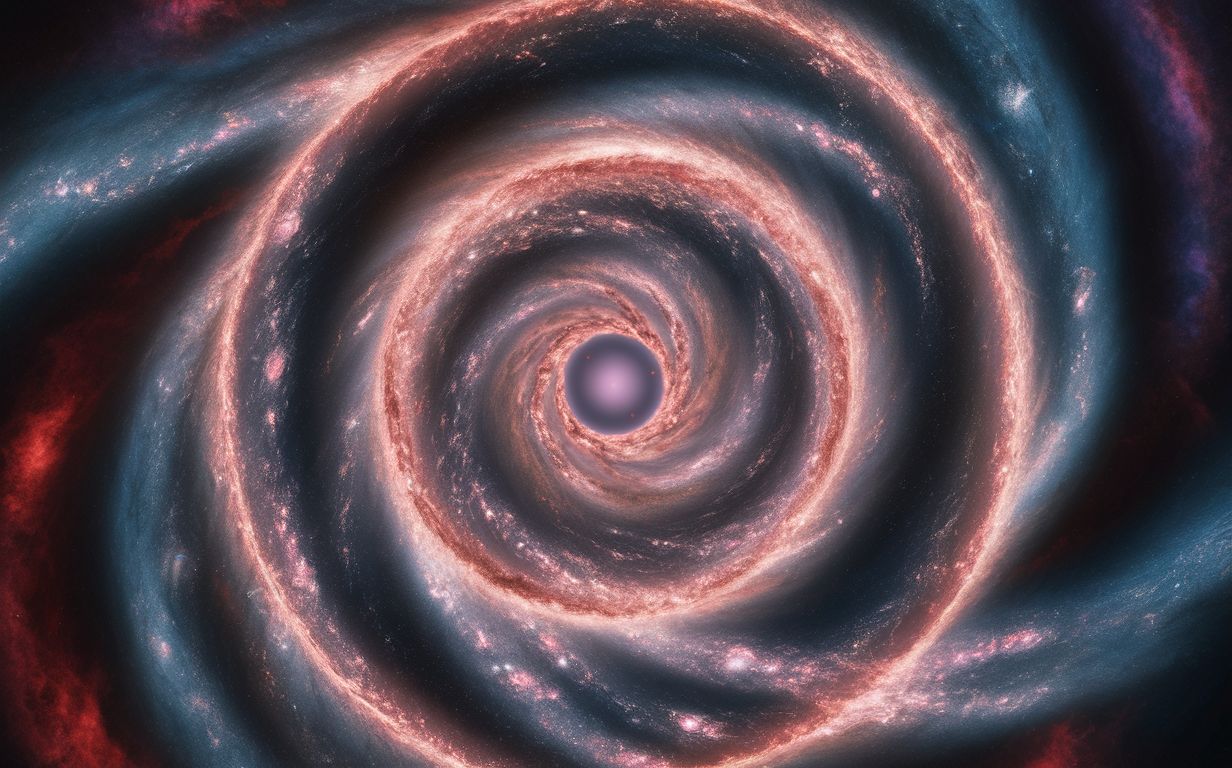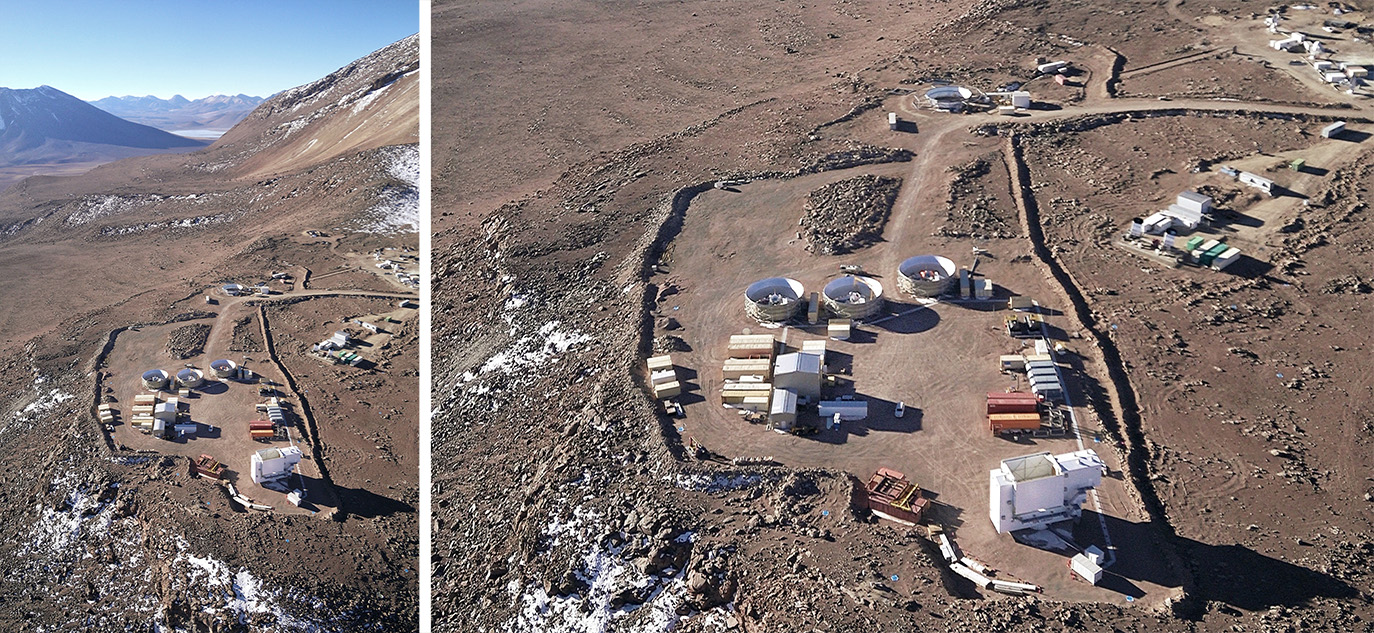Follow us on Google News (click on ☆)

The goal is to try to detect in these first glimmers of the cosmos the minute traces of gravitational waves that would have been generated by an inflationary phase of the primordial Universe. Two IN2P3 laboratories, APC and IJCLab, are participating in this project.
The Simons Observatory has just completed its main construction phase on the heights of the Atacama Desert in Chile and will now begin data collection, which is expected to lead to the most precise measurements ever made of the oldest light in the Universe. This light, known as the cosmic microwave background (CMB), was emitted about 380,000 years after the Big Bang and holds the secrets of the cosmos's birth.
Indeed, scientists predict that a period of rapid expansion of the Universe in its very first moments, called inflation, may have generated gravitational waves in the fabric of space-time. These waves affect the polarization properties of the CMB, imprinting a particular pattern that cosmologists call "B-mode polarization.”
"Their discovery would provide unprecedented insight into how the Universe was born and offer confirmation of the inflation theory," explains Mark Devlin, co-director of the observatory from the University of Pennsylvania. "The amplitude of primordial B-modes will inform us about the state of the Universe in the first moments after its birth.”
"The question of the origin of the Universe has always fascinated humans," states Brian Keating, principal investigator of the observatory from the University of California at San Diego. "With the Simons Observatory, we are on the verge of discovering answers rooted not in mere speculation but in the most precise data ever collected by the world's most advanced telescopes.”
"We are taking research on the primordial Universe to a new level," says Suzanne Staggs, co-director of the Simons Observatory at Princeton University. "The sensitivity of our instruments opens new perspectives for the field."
The quest
One of the main scientific objectives of the Simons Observatory is to help elucidate what occurred in the first decillionth of a second after the Big Bang (that is, a trillionth of a trillionth of a billionth of a second). In this brief instant, scientists believe the Universe expanded by a factor of 100 trillion trillion. This would be comparable to a bacterium growing to the size of a galaxy.

To take advantage of ideal observation conditions, the Simons Observatory is established on Mount Toco at nearly 17,000 feet (5,200 meters) altitude in the Atacama Desert, Chile. Pictured are the three 40-centimeter aperture telescopes (SAT), surrounded by a screen protecting them from terrestrial emissions, and in the foreground, the structure of the 6-meter (about 20 feet) aperture telescope (LAT) being installed.
Image: Gabriele Coppi, Rolando Dunner, Ederico Nati, Matias Rojas
Quantum fluctuations in the primordial Universe would have generated the first inhomogeneities in the cosmos, which later evolved to create the distribution of matter we observe in the modern Universe. These same fluctuations also generated ripples in space-time known as primordial gravitational waves.
Although this inflationary period was a crucial moment in the history of the Universe, we cannot observe it directly. The early Universe was too hot and dense for light to propagate freely. Only after 380,000 years of evolution, and the cooling of the plasma that constituted the primordial Universe, could light begin to move unimpeded. This is the cosmic microwave background we observe today.
Much like light passing through polarized sunglasses, the light from the CMB can have a preferred orientation, or "polarization." The gravitational waves from inflation would have left subtle patterns called B-modes in the CMB polarization. Detecting these B-modes would provide unprecedented information about the earliest moments of the Universe.
"We are on the hunt for a signal generated during the first billionth of a trillionth of a trillionth of a second after the Big Bang," says Arthur Kosowsky, spokesperson for the Simons Observatory collaboration from the University of Pittsburgh. "Nobody knows if the signal is still large enough to be seen today. Seeing it would be like winning the physics lottery—the scientific impact would be immense.”
Mapping the cosmic microwave background
The Simons Observatory includes three small aperture 16-inch (0.4-meter) telescopes (SAT) and a large aperture 20-foot (6-meter) telescope (LAT) that will together achieve unprecedented sensitivity in measuring the CMB polarization. As of April 2024, two of the SATs have been calibrated and are now in observation mode; the third SAT is expected to become operational in the coming months, and the LAT early next year.

Image of the planet Jupiter with the Simons Observatory detectors. The apparent size of the planet reflects the resolution of the telescope optics. The scans of Jupiter are among the first observations and have been used to calibrate the observatory's instruments.
Image: The Simons Observatory collaboration
The size of the Simons Observatory and the innovative use of new technologies enable it to create detailed maps of the CMB at a rate several times higher than that of the previous generation of telescopes. Together, the observatory's four telescopes will have 60,000 detectors collecting data, more than all other projects combined.
The observatory's superconducting detectors operate at temperatures of 0.1 degrees above absolute zero, using cooling technology similar to that used for quantum computers. “I'm impressed that our instruments work so well,” says Jeff McMahon, a founding member of the Simons Observatory from the University of Chicago. "I'm even more enthusiastic about the scientific data these telescopes are beginning to produce.”
The three SATs will collectively survey an area covering 20% of the southern hemisphere sky, while the LAT will map 40% of the sky with finer resolution. By combining the sensitivity of the telescopes with innovative data analysis techniques, the Simons Observatory team maximizes its chances of detecting the elusive B-modes.
The future of the observatory
After about four years of operation, the observatory will benefit from the addition of 30,000 more detectors, thanks to a grant awarded by the National Science Foundation (United States). The total observation period for the telescopes will be about 10 years.
"Ten years may seem long, but using the current telescope capabilities, it would take 60 years to reach our sensitivity," explains Mark Devlin. Additional telescopes funded by Japan and the United Kingdom are also expected to come online in 2026, doubling the number of SATs.
French participation in the observatory
IN2P3 teams are taking part in the Simons project, with participation from the APC and IJCLab laboratories.
"Detecting B-mode polarization is like finding a needle in a haystack," explains Josquin Errard, laureate of a European research grant (ERC) and co-leader of primordial B-mode measurements within the collaboration. "CMB observations are affected by all sorts of emissions from astrophysical and environmental origins that contaminate the signal, particularly emissions from our own galaxy: the Milky Way. We are developing new data analysis methods that will separate the different contributions.”
Meanwhile, a possible French instrumental contribution to the observatory is under discussion, led by LPSC in partnership with CNRS Physics and CNRS Earth & Universe. The aim is to add a new SAT focusing on the characterization and subtraction of galactic dust emissions that contaminate the cosmological signal; this new telescope would fully exploit the observatory's sensitivity to primordial gravitational waves.
"With the success of the Planck satellite mission, France has positioned itself as a leader in primordial Universe science. Enhanced participation by our community in the observatory would leverage all of our expertise, be it instrumental or in data analysis," adds Thibaut Louis, a researcher at IJCLab and head of the "Simons Observatory" project at IN2P3.
About the Simons Observatory
The scientific team of the Simons Observatory comes from the merger of two collaborations: the Atacama Cosmology Telescope and the Simons Array. In 2014, mathematician and co-founder of the Simons Foundation, Jim Simons, proposed funding this new collaboration.
Extensions to the initial project have been funded by the National Science Foundation (United States), and by research and innovation funds in the United Kingdom and Japan. The project has also received financial support from the founding universities: Princeton, Berkeley, San Diego, Chicago, and Pennsylvania. In total, the collaboration brings together over 350 researchers from more than 35 institutions.